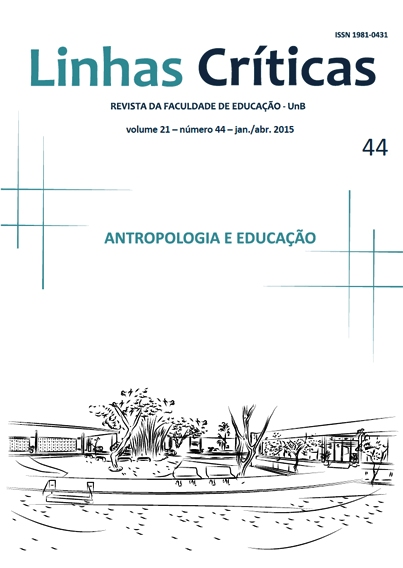A dialog on the relations among ethnography, culture and education ”“ representations and practices
DOI:
https://doi.org/10.26512/lc.v21i44.4465Keywords:
Anthropology, Education, TeachingAbstract
This paper intends to discuss the limits and possibilities of teaching anthropology and ethnographic practice outside of the Social Sciences, more specifically in the field of Education. Beginning with a brief discussion of the deployments of anthropology as a teaching and research area, the article shows the way in which this discipline has marked the production of knowledge in the field of Education, especially my experience as university professor and Masters and Doctorate advisor, during which I have followed an interdisciplinary path between Anthropology and Education.
Downloads
References
BRANDÃO, Carlos Rodrigues. Introdução à antropologia como educação. In: ROCHA, Gilmar; TOSTA, Sandra Pereira. Antropologia & educação. Belo Horizonte: Autêntica, 2009. pp. 11-159.
CHARTIER, Roger. A história cultural - entre práticas e representações. Lisboa: Difel, 1990. (Memória e Sociedade)
DAUSTER, Tania. Navegando contra a corrente? O educador, o antropólogo e o relativismo. In: BRANDÃO, Zaia (Org.). A crise dos paradigmas e a educação. São Paulo: Cortez, 1994. pp.75-87.
_______; GROSSI, Miriam Pillar; GUEDES, Simoni Lahud. Resumo da atividade no Fórum 03: O fazer antropológico e o processo de orientação: encontros e desencontros. In: Reunião de Antropologia do Mercosul, 5, 30/nov a 03/dez de 2003, Florianópolis, Programas e resumos. Antropologia em perspectivas. 2003. Florianópolis: PPGAS/UFSC, 2003.
_______. Construindo pontes ”“ a prática etnográfica e o campo da educação. In: DAYRELL, Juarez (Org.). Múltiplos olhares sobre educação e cultura. Belo Horizonte: UFMG Editora, 1996. pp. 65-72.
_______. Um outro olhar ”“ entre a antropologia e a educação. In: GUSMÃO, Neusa Maria Mendes de. Antropologia e educação ”“ interfaces do ensino e da pesquisa. Campinas: Centro de Estudos Educação e Sociedade, 1997.
_______. (Org.). Antropologia e educação ”“ um saber de fronteira. Rio de Janeiro: Forma & Ação, 2007.
_______. Etnografia, modo de conhecer: entre a antropologia e educação. In: Educação On-Line, n.9, pp. 1-12, 2012.
_______; TIBAU, Anderson. Desafios da construção de uma etnografia em educação: questões de interdisciplinaridade. Manuscrito inscrito na 29.a Reunião Brasileira de Antropologia realizada entre os dias 03 e 06 de agosto de 2014, Natal/RN.
DURKHEIM, Émile. Educação e sociologia. São Paulo: Melhoramentos, 1952.
DaMATTA, Roberto. Ensaio de sociologia interpretativa. Rio de Janeiro: Rocca, 1986.
GEERTZ, Clifford. A interpretação das culturas. Rio de Janeiro: Jorge Zahar, 1978.
_______. Os usos da diversidade. In: Horizontes Antropológicos. n. 10. Diversidade e Cidadania. Porto Alegre: PPGA/UFRGS,1999.
GUSMÃO, Neusa Maria Mendes de. Antropologia e educação: origens de um diálogo. In: _______. Antropologia e educação ”“ interfaces do ensino e da pesquisa. Campinas: Centro de Estudos Educação e Sociedade, 1997.
INGOLD, Timothy. Anthropology is not ethnography. In: Proceedings of the British Academy, n. 154, pp.69-92, 2008.
_______. Humanidade e animalidade. Disponível em: <http://www.anpocs.org.br/portal/publicacaos/rbcs_00_28/rbcs28_05>. Acesso em: 28 jan. 2013.
LAPLANTINE, François. Aprender antropologia. São Paulo: Editora Brasiliense, 1988.
LARAIA, Roque de Barros. Cultura: um conceito antropológico. Rio de Janeiro: Jorge Zahar Editor, 1986.
LIBÂNIO, José Carlos. Pedagogia e pedagogos, para quê? São Paulo: Cortez, 2007.
LÉVI-STRAUSS, Claude. Antropologia estrutural. Rio de Janeiro: Tempo Brasileiro, 1985. (Biblioteca Tempo Universitário)
MALINOWSKI, Bronislaw. Objeto, método e alcance desta pesquisa. In: GUIMARÃES, Alba Zaluar (Org.). Desvendando máscaras sociais. Rio de Janeiro: Livraria Francisco Alves, 1975. pp.39-61
Mauss, Marcel. Ensaio sobre a dádiva. In: _______. Sociologia e antropologia. São Paulo: Editora Pedagógica e Universitária; Edusp, 1974. Vol. II. pp. 37-178.
_______. As técnicas corporais. In: _______. Sociologia e antropologia. São Paulo: Editora Pedagógica e Universitária; Edusp, 1974. Vol. II. pp.209-233.
_______. A expressão obrigatória dos sentimentos. In: _______. Antropologia. São Paulo: Ática, 1979. pp.147-153.
NOVAES, Regina. Um olhar antropológico. In: NILDA, Teves (Org.). Imaginário social e educação. Rio de Janeiro: Gryphus, 1992.
OLIVEIRA, Roberto Cardoso de. O trabalho do antropólogo. São Paulo: UNESP/Paralelo 15, 1998.
PEIRANO, Marisa. A favor da etnografi a. Rio de Janeiro: Relume-Dumará, 1995.
ROCHA, Gilmar; TOSTA, Sandra Pereira. Antropologia & educação. Belo Horizonte: Autêntica, 2009. pp.11-159.
SILVA, Helio. A situação etnográfica: andar e ver. Horizontes Antropológicos, ano 15, n. 32, pp.171-188, jul/dez. 2009.
VELHO, Gilberto. Individualismo e cultura. Rio de Janeiro: Jorge Zahar Editor, 1981.
_______. Biografia, trajetória e mediação. In: _______; KUSCHNIR, Karina (Orgs.). Mediação, cultura e política. Rio de Janeiro, Aeroplano Editora, 2001. pp.13-28.
_______. Observando o familiar. In: NUNES, Edson. (Org.). A aventura sociológica. Rio de Janeiro: Zahar, 1978. pp.36-46.
_______. Entrevista concedida em 3 de julho 2001 a Celso Castro, Lucia Lippi Oliveira e Marieta de Moraes Ferreira. Estudos Históricos, n. 28, pp.183-210, 2001.
Downloads
Published
How to Cite
Issue
Section
License
Copyright (c) 2016 Linhas Críticas

This work is licensed under a Creative Commons Attribution 4.0 International License.
Authors who publish in this journal agree to the following terms:
-Authors maintains the copyright and grants the journal the right of first publication, the work being simultaneously licensed under the Creative Commons Attribution License which allows the sharing of the work with recognition of the authorship of the work and initial publication in this journal.
- Authors are authorized to enter into additional contracts separately, for non-exclusive distribution of the version of the work published in this journal (eg publish in institutional repository or as a book chapter), with acknowledgment of authorship and initial publication in this journal.
-Authorers are allowed and encouraged to publish and distribute their work online (eg in institutional repositories or on their personal page) at any point before or during the editorial process, as this can generate productive changes as well as increase the impact and the citation of published work (See The Effect of Free Access).



